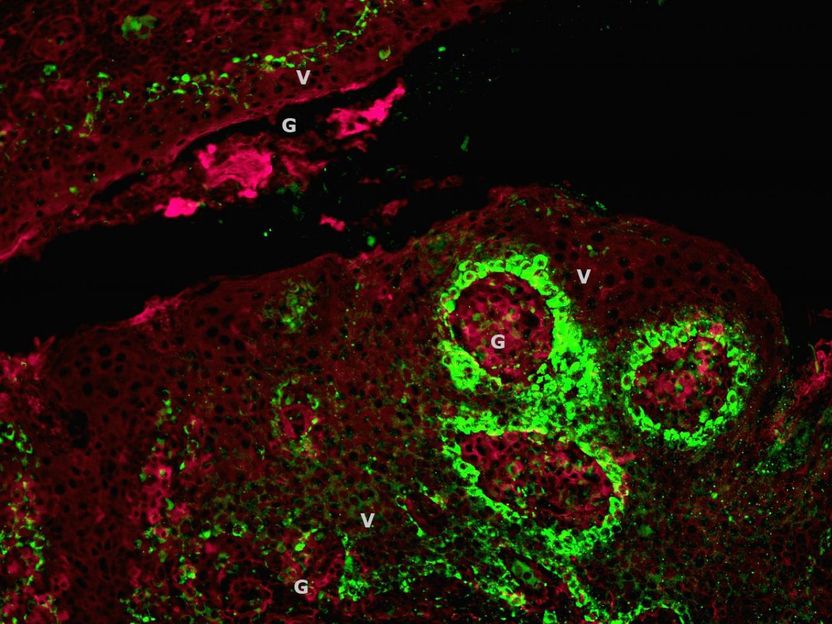Carbohydrate-binding proteins mitigate parasitic infection in heart tissue
Chagas disease is the main cause of infectious heart disease in Latin America. Researchers from the INGEBI and IBYME Institutes in Argentina explored the effect of glycan binding protein interactions between the human host and Typanosoma cruzi parasite. They found that a glycan binding protein expressed in humans modified the infection in cells of the heart muscle, showing the importance of galectins in the response to parasite infection.
Galectins are a group of carbohydrate-binding proteins which are used both inside and outside the cell for signalling and regulation. Previous research has indicated their involvement in parasite infections, and the galectin Gal-1 has been shown to be up-regulated in heart cells exposed to low oxygen or undergoing inflammation. Gal-1 is also up-regulated in heart tissue from patients with severe chronic Chagas cardiomyopathy.
In this study, the researchers examined 28 patients, 19 with cardiac symptoms and 9 who were in the asymptomatic phase of the disease. Comparing them with 42 non-infected individuals demonstrated that the patients with Chagas disease had higher Gal-1 levels whether symptomatic or not. Studies of infected heart tissue cells showed that T. cruzi increased Gal-1 release outside of the cells, without affecting the intracellular expression. Gal-1 was demonstrated to mitigate cellular parasite infection and prevent early signs of heart cell apoptosis but did not bind to the parasite itself. The researchers also examined mice lacking the gene for Gal-1 and found that these mice had increased parasitemia and decreased survival rate following T. cruzi (Tulahuén strain) infection compared with wild type mice. This work also highlights the relevance of parasite genetic background in Gal-1-mediated control of T. cruzi infection in vivo.
Based on these results, the researchers hypothesize that Gal-1 may recognize and bind to glycans on the heart cell surface used for parasite invasion, preventing parasite attachment and probably activating the immune response to the parasite by cytokine release. Conversely, T. cruzi may alter surface glycophenotype of cardiac cells, restricting Gal-1 interaction. The role of galectins in parasite-host cell interactions is a fascinating but under-explored area, and more research should provide a clearer pattern of the importance of these glycan binding proteins in mitigating parasitic infections.
Original publication
Alejandro F. Benatar, Gabriela A. García, Jacqeline Bua, Juan P. Cerliani, Miriam Postan, Laura M. Tasso, Jorge Scaglione, Juan C. Stupirski, Marta A. Toscano, Gabriel A. Rabinovich, Karina A. Gómez; "Galectin-1 Prevents Infection and Damage Induced by Trypanosoma cruzi on Cardiac Cells"; PLoS Negl Trop Dis; 2015
Most read news
Original publication
Alejandro F. Benatar, Gabriela A. García, Jacqeline Bua, Juan P. Cerliani, Miriam Postan, Laura M. Tasso, Jorge Scaglione, Juan C. Stupirski, Marta A. Toscano, Gabriel A. Rabinovich, Karina A. Gómez; "Galectin-1 Prevents Infection and Damage Induced by Trypanosoma cruzi on Cardiac Cells"; PLoS Negl Trop Dis; 2015
Other news from the department science

Get the life science industry in your inbox
By submitting this form you agree that LUMITOS AG will send you the newsletter(s) selected above by email. Your data will not be passed on to third parties. Your data will be stored and processed in accordance with our data protection regulations. LUMITOS may contact you by email for the purpose of advertising or market and opinion surveys. You can revoke your consent at any time without giving reasons to LUMITOS AG, Ernst-Augustin-Str. 2, 12489 Berlin, Germany or by e-mail at revoke@lumitos.com with effect for the future. In addition, each email contains a link to unsubscribe from the corresponding newsletter.
Most read news
More news from our other portals
Last viewed contents
Lowering pH regulates spider’s silk production

Tosoh Bioscience – Separation & Purification Expands European Headquarters in Griesheim, Germany - "This new facility will allow us to better serve our customers and explore new chromatography techniques and applications"

New pharmaceutically active substances from billions of newly combined molecules - “We’re seeing immense interest from industry and research, especially in cyclic molecules, which to date haven’t been accessible in large numbers”
Pharming's Ruconest(TM) for HAE granted European Marketing Authorization
Analytik Jena AG establishes subsidiary in Thailand

Stolze Science & Business Consulting - Hannover, Germany
Sartorius Stedim Biotech and Bosch Packaging Technology Announce Global Collaboration

Bacteria acquire resistance from competitors

HPV may lurk in your throat

The origins and ID of pancreatic endocrine cells - Endocrine stem cells in the pancreas disappear after birth





















































